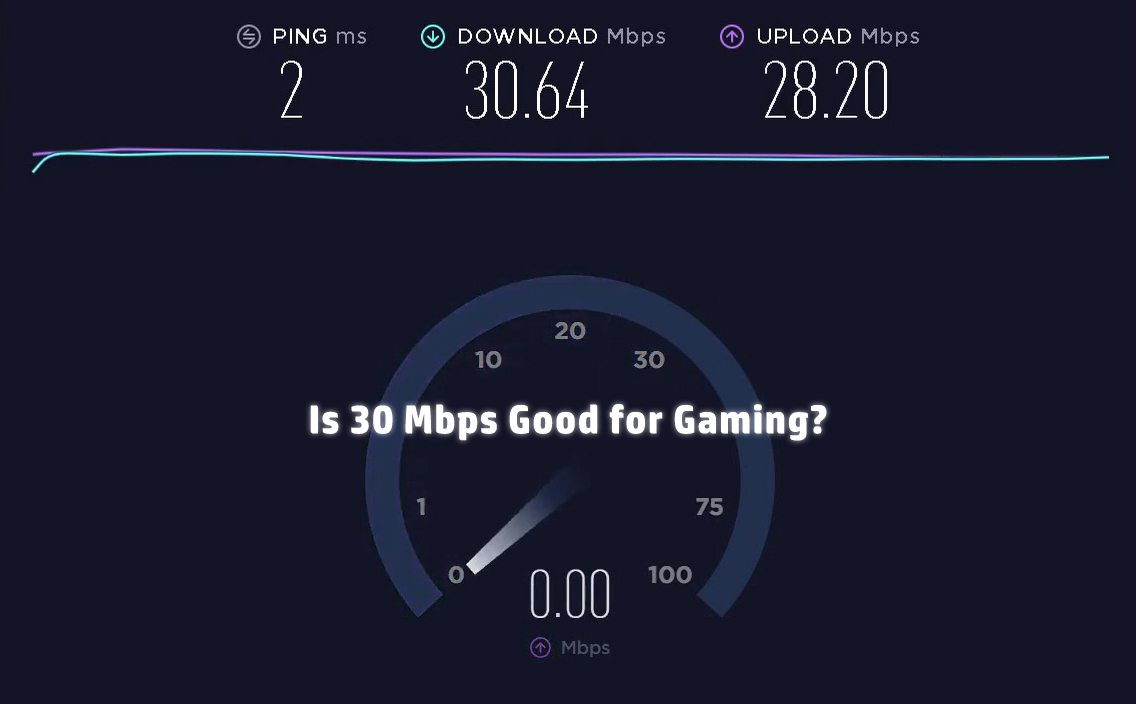A simple Google search will tell you that you need just 3 Mbps download and 1 Mbps upload to play games online but is it really that simple? Does that mean that you can easily play any online game with 30 Mbps? Are there other factors involved? Can those factors make a game unplayable even if your speeds are much higher than 30 Mbps? Is there a way (or ways) to improve your gaming experience and make it smoother? Read this article, and you will find all the answers.
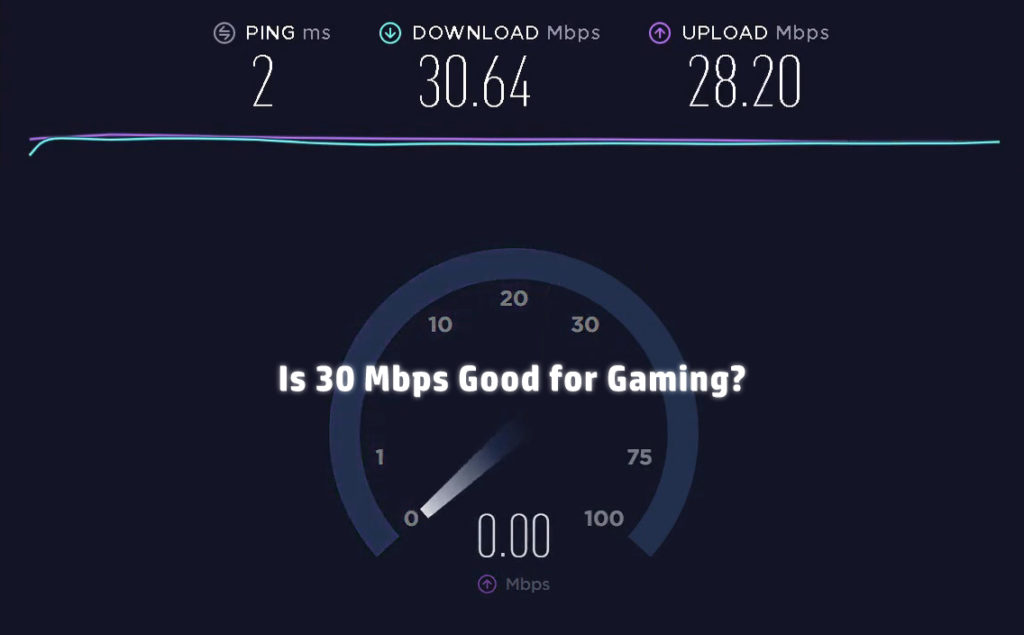
CONTENTS
- Is 30 Mbps Fast? What Can I Do with 30 Mbps?
- Internet Speed Requirements for Online Gaming
- How Much Speed Do I Need for Traditional Online Gaming?
- How Much Speed Do I Need to Stream Games while Playing?
- What Are the Speed Requirements for Cloud Gaming (Stadia, PS Now, GeForce Now, etc.)?
- Is Speed the Only Thing I Need for Online Gaming?
- Ways to Improve Gaming Experience
- Our Verdict – Is 30 Mbps Fast Enough for Online Gaming?
- FAQ
Is 30 Mbps Fast? What Can I Do with 30 Mbps?
From today’s point of view, the answer would have to be no. The answer would have been quite different 5 years ago, but lots of things have changed since. Today, we have an expansion of fiber optic network with Gigabit speeds. We also have a huge cable internet network that can also deliver Gigabit speeds (at least download speeds). More than half of the US citizens have access to Gigabit speeds. Compared to those speeds, 30 Mbps is not much.
On the other end of the speed spectrum, we have large rural areas of the US with poor internet infrastructure and without access to high-speed internet. Some areas even lack access to broadband internet (25/3 Mbps). There are also areas where you can’t get more than 10 Mbps or 5 Mbps. If you ask those people if 30 Mbps is fast, the answer would be yes.
So, how fast 30 Mbps really is? Is that enough for movie streaming? Is it good enough for Zoom calls? What about Skype? Can you work from home with 30 Mbps? The answer to all those questions is yes. But there’s a catch. You can’t do all those things at once.
30 Mbps is fast enough for any online activity that you’re doing every day. It even allows you to stream movies in 4K using any movie streaming service (YouTube, Netflix, Hulu, Amazon Prime, Apple TV+, etc.). You can also stream videos on multiple devices (up to 6) in 1080p.
You can have smooth conference calls via Zoom or Skype in HD with 30 Mbps. You can stream music with 30 Mbps. You can work or study from home with 30 Mbps. You can download large files in a relatively short time. But what happens when you are trying to do multiple things at once?
Recommended reading:
- Will a New Router Increase Internet Speed?
- Does Bridging Connections Increase Speed?
- Can You Have Two Modems In One House Spectrum?
Imagine the following scenario – you are trying to download a large file while having a Skype call, your husband/wife is watching a movie on Netflix, and your kid is playing games on Stadia? All those activities require a lot of bandwidth. Doing them all at once with just 30 Mbps is practically impossible. Your kid will definitely experience some lag and stuttering, your wife/husband will have to deal with buffering, and your Zoom/Skype call will hardly be smooth. The download won’t stop, but it’ll take much longer.
So, while 30 Mbps is perfectly enough for any everyday online activity, it’s only good if you have, let’s say, 3-4 simultaneously connected devices, and if you are not doing some bandwidth-demanding activities on all of them at once. If you have more than 3-4 connected devices and multiple people are using those devices at the same time, you should probably get more than 30 Mbps. 100-200 Mbps download is ideal for an average household. Anything higher than that is great.
Internet Speed Requirements for Online Gaming
Online gaming is not a demanding activity. It doesn’t require high speeds. According to FCC, you need just 3 Mbps for online gaming using gaming consoles and 4 Mbps for multiplayer online games.
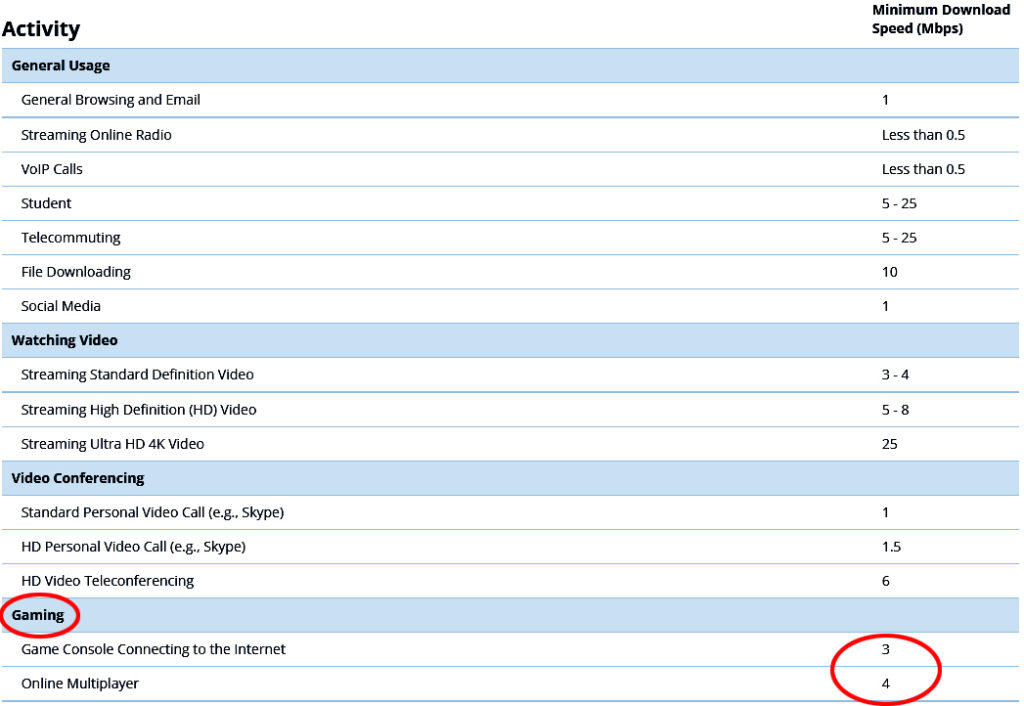
How Much Speed Do I Need for Traditional Online Gaming?
Whether you’re using a console or a PC, traditional online gaming needs 3-4 Mbps download and 0.5-1 Mbps upload. When we say traditional, we are referring to old-school online gaming – all the gamers have the same version of the game installed on their PCs. Your PC does all the rendering, and the only information sent to the game server is info about the player, your position, status, commands, and communication between the gamers. This kind of gaming doesn’t include video streaming (you don’t have to receive or send video streams), and that’s the main reason why you need just a few Mbps.
How Much Speed Do I Need to Stream Games while Playing?
Streaming your game on Twitch, YouTube Gaming, DLive, or some other streaming platform, while playing, adds some load to your bandwidth. You will still need 3-4 Mbps download and 1 Mbps upload for gaming, but you will need a few more Mbps of upload to send your online stream. Twitch, for example, requires 3-6 Mbps if you want to stream. 3 Mbps upload is needed for the lowest quality (720p/30fps), and 6 Mbps is needed for the highest quality (1080p/60fps).
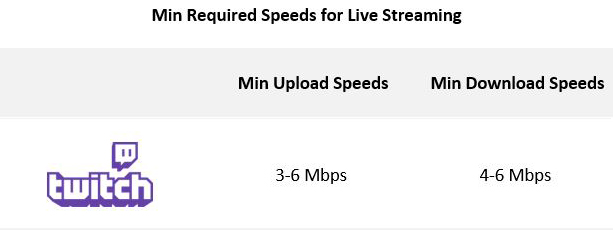
So, while you need 1 Mbps upload for smooth online gaming, you need additional 6 Mbps of upload to stream games. You also need 4-6 Mbps to watch live streams on Twitch.
While 30 Mbps is good enough for traditional online gaming and watching Twitch streams, you need 4-7 Mbps upload if you want to create streams. Unless you have a fiber plan, you will hardly be able to stream on Twitch while playing. Cable and DSL plans come with asymmetrical download and upload speeds. If your download is 30 Mbps, your upload speed will range between 3 and 5 Mbps.
What Are the Speed Requirements for Cloud Gaming (Stadia, PS Now, GeForce Now, etc.)?
Cloud gaming, sometimes called gaming-on-demand, is very different from traditional online gaming. Cloud gaming services are actually more similar to video-on-demand services. Cloud gaming, in a way, is like Netflix. You don’t need a game installed on your PC. You don’t need an expensive gaming PC to run games. Everything is rendered on a remote server and then sent to you as a video. You’re basically streaming the game from a cloud. You can play it on your PC, console, laptop, smartphone, tablet, etc.
So, you don’t need powerful equipment for cloud gaming, but you do need a fast internet connection. Or at least faster than for traditional gaming. Since the video is streamed to your PC, you need much higher download speeds to receive the video. Your upload speeds are not crucial – you need at least 1 Mbps, just like with traditional gaming.
Advantages and Disadvantages of Playing Stadia Games (4K/60fps, 30 Mbps)
Depending on the quality of the video you want to receive, you will need between 5 and 15 Mbps for 720p, 15-30 Mbps for 1080p, and 45+ for 4K. Have in mind that the recommended speeds are bare minimums and that games usually don’t run smoothly at those speeds. From time to time, the image will get blurry, you will experience stuttering, lag, etc. So, even though you can, in theory, play games on PS Now with 5 Mbps, you need more than 5 Mbps for smooth gaming. The same thing applies to Stadia, GeForce Now, Vortex, Amazon Luna, and other services.

So, while 30 Mbps may seem enough for gaming in 1080p on any of the above-mentioned services, we can’t guarantee a great experience. It’d be best to try these services on your own and see if it’s good enough. Or just stick to traditional online gaming.
Is Speed the Only Thing I Need for Online Gaming?
No. Speed is not the only thing you need. While it’s important, it is not the only thing necessary for smooth gaming. Other online activities also depend on other characteristics of your internet connection, but not as much as gaming. They are simply not as affected, and you won’t even notice if those characteristics are bad, even if the activity is much more bandwidth-demanding than online gaming.
Besides good internet speed, three things are crucial for your gaming: latency (ping), jitter, and packet loss.
Ping/Latency
Latency is, by far, the most important. It’s measured in milliseconds, and it represents the time needed for a packet of data coming from your PC to reach the server and then return back to you. When you are using the left mouse click to shoot someone, the time that passes from the moment you press the button to the moment your command is executed is latency. If it feels instantaneous, your latency is good. If you can see the delay between your command and execution, it’s bad.
For a good gaming experience, you need your latency to be under 60ms. Competitive gamers will want it under 30, or even under 20ms. You may not notice any issues if your latency is below 130ms. If it’s between 130 and 200ms, there will be some noticeable issues, but if it’s higher than 200ms, it will be impossible to play the game.
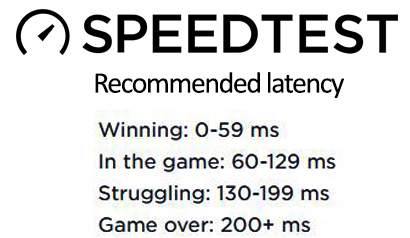
Latency is affected by many things – the quality of your equipment, distance between you and the server, your internet connection type, infrastructure quality, etc.
What is Internet Latency
Equipment Quality
Every data packet (every command, change of position, change of your status) has to be processed by your PC, sent to your router, then processed by the router, sent to the game server, then processed by the server, sent back to your router, processed by the router, and then sent to the PC. It’s a long trip. Every station on that path introduces some latency. If your equipment is of higher quality, the data will be processed faster, and the latency will be lower.
Home Network Configuration (Wired/Wireless Connection, Switches, Repeaters, Extenders)
If a data packet has to pass more stations before reaching the destination, the latency will be higher. So, if you have a switch connected to your gateway/modem, and then your PC connected to the switch, the latency will be higher than when your PC is directly connected to the modem/gateway. It’s even worse if you have a repeater connected wirelessly to the router/gateway, and then your PC connected wirelessly to the repeater – the latency will be even higher. Even if your PC is directly connected to the modem/gateway/router via Wi-Fi, the latency will be higher than when using a wired connection.
Ideally, you will have your PC connected via Ethernet cable directly to your gateway or router. That’s the best way to lower the latency on your end.
Game Server Proximity
This is very important. Just like we need some time to cross some distance, a data packet going from your PC needs some time to reach the game server. And then needs some time to go back to your PC. If the server is further away from your location, then your latency will be higher.
Internet Connection Type
Most internet connection types will deliver satisfying latency, often below 40ms. FCC did a study a few years ago, and that study showed that fiber internet delivers average latency lower than 20ms. Today, fiber connection can deliver latency lower than 10ms. This connection type is, by far, the most desirable for pro and competitive gamers.
Cable is the second-best option. According to the FCC study, the average latency of cable connection ranges between 15-35ms. It’s not as good as fiber, but it can still give you a very good gaming experience.
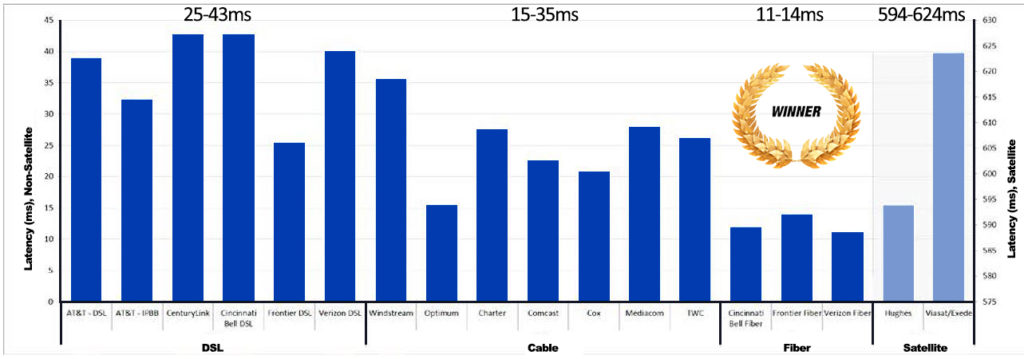
DSL delivers even higher latency than cable, but it’s still acceptable and, with the right choice of server, it can be pretty low (still much lower than 60ms).
Fixed wireless connection is similar to DSL when it comes to latency. Depending on the quality of the infrastructure and the distance between your dish and the transmitter, the latency can be lower than 40ms. So, gaming with fixed wireless is still possible.
Satellite connection is the only problematic type. The reason is simple – the signal sent from your PC has to travel from the dish on your roof to the satellite. The latency introduced by this kind of internet connection is huge, often higher than 600ms. That’s simply unacceptable for gaming. Some innovations, like Starlink, may change this in the future and make the latency lower but, at the moment, we can’t recommend satellite internet for gaming.
Gaming Over Starlink
Congestion
Some internet connection types, especially cable internet, are susceptible to congestion – during peak hours, your connection performance may get worse (lower bandwidth, higher latency, higher packet loss, and higher jitter).
Jitter
Jitter tells you how consistent your latency is. If it varies a lot over time, your jitter will be high. High jitter is not good for gaming – because of it, data packets may arrive at the destination in the wrong order, which often manifests in screen stuttering.
Jitter is measured in ms (milliseconds), like latency. It is a standard deviation from the mean latency value over some time. Acceptable jitter level is anything below 30ms.
Network Jitter Explained
Packet Loss
Packet loss is never good. It occurs when your internet connection is overburdened and when your router doesn’t have enough bandwidth to send/receive all the data at once. When that happens, your router will simply drop some packets.
An acceptable packet loss value is anything below 1%. Ideally, it will be 0. Packet loss can be caused by too much traffic, but it can also be a hardware problem (a problem with your router and/or modem) or a problem with other infrastructure. Generally speaking, packet loss happens more often when using Wi-Fi.
Packet Loss Explained
Ways to Improve Gaming Experience
You can improve your gaming experience (reduce latency and jitter, improve bandwidth, etc.) in many ways. We have prepared a list of things you can do to perfect your gaming performance and make your internet connection more gaming-friendly. Some of the following methods are simple and almost self-explanatory, while others require a little bit of technical knowledge and time to understand.
Use Wired Connection
Wired (and direct) connection to your modem/gateway is a much better option than Wi-Fi, especially for gaming and video conferencing. You will get better bandwidth, but that’s not the most important thing since you don’t really need that much bandwidth for gaming (especially for traditional gaming). What is important is that a wired connection delivers much lower latency, jitter, and lower packet loss.
When we say direct connection to your modem/router, we mean that you shouldn’t use repeaters, Wi-Fi extenders, or switches for gaming (especially Wi-Fi repeaters). Your PC must be directly connected to the gateway.
If you have to use Wi-Fi, then you should at least try using the 5 GHz band instead of 2.4 GHz. There’re simply too many devices in our homes using the 2.4 GHz band, and that can result in interference. Interference leads to lower speeds, higher latency, and higher jitter.
Difference Between Gaming Over Wi-Fi and Gaming with Ethernet Cable
Restart your Equipment (Modem, Router, PC)
Restarting your devices, regardless of how silly or naive it sounds, can give you a fresh new start. It will refresh your OS and your modem/router. It may resolve an IP address conflict, remove a bug from your router’s firmware, etc. It can also solve problems with your PC. If the Windows is laggy, there’s a chance that a misbehaving program drains your PC’s resources. Restarting will close the program and bring your PC to normal. You could try finding the program and closing it manually, but a simple restart is a quicker solution.
So, even though it seems silly, try restarting your PC and other equipment before doing anything else.
Use the Closest Game Server
As discussed, the distance between you and your game server has a huge effect on latency. The closer the server, the lower the latency. Our advice is super simple – choose the closest server. If you can choose between a server in your state and some other state (or an entirely different country), choose the one in your state.
Optimize Your PC and Your Internet Connection
Optimizing PC and Internet connections includes a wide range of actions. Some are simple and self-explanatory, while others are a bit more complex.
Simple things that you can do include stopping all the downloads and closing all the programs running in the background. This can be beneficial even if you have a high-speed internet plan and a powerful computer.
More complex settings are done on a software level and require much more time, especially if you want to understand what you’re doing. Some of the things you should do include changing Ethernet/Wi-Fi adapter driver settings and stopping all the Windows/Microsoft background services that are not really necessary for gaming.
Below, you can find a simple guide with detailed explanations on how to optimize your connection.
Step-by-Step – Optimizing PC and Internet Connection
Update Your Drivers and Firmware
Many users and gamers often neglect the importance of driver and firmware updates, mostly because you usually don’t see any difference in performance after installing the updates. However, it happens occasionally that an update is designed to improve network performance and, consequently, improve your gaming experience.
Use QoS Settings to Prioritize Game Traffic
Regular people don’t like messing with the router’s settings, but learning a few things about routers, especially about QoS settings, can bring your gaming to a whole new level.
Through QoS settings, you can change priority settings for different services/applications, different IP/Mac addresses, or even different LAN ports. You can even dedicate a certain portion of the bandwidth (or the entire bandwidth) to that service/device/port.
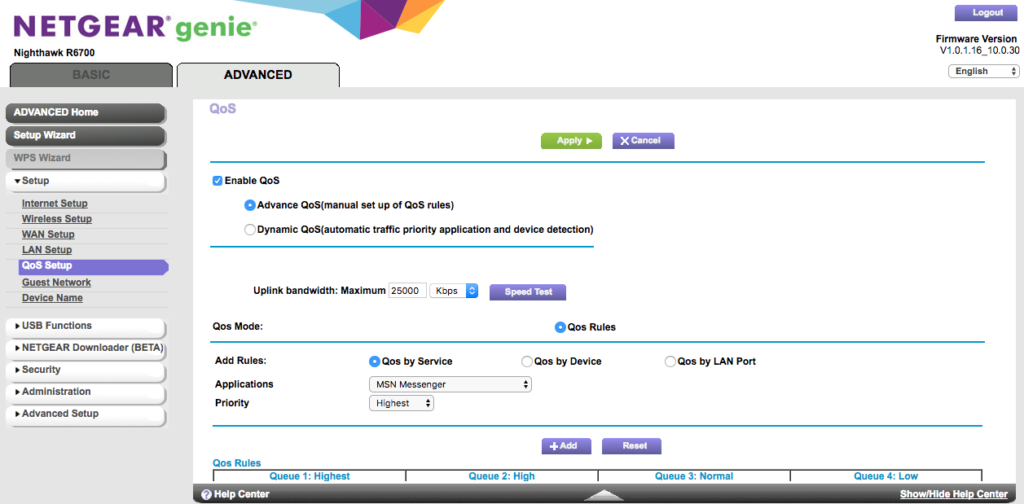
QoS Settings (NETGEAR router)
By giving priority to your gaming device(s), you will get all the bandwidth you need for gaming, and the rest of the bandwidth will be shared between other connected devices.
Router Settings for Gaming
Avoid Peak Hours (Cable Internet)
As discussed earlier, certain internet connection types, especially cable internet can suffer from congestion. During peak hours, your connection may get slower and your latency (along with jitter and packet loss) may increase. In this case, the only advice we can give you is to avoid peak hours.
Our Verdict – Is 30 Mbps Fast Enough for Online Gaming?
30 Mbps is not bad at all. It’s pretty good for gaming, but only if you’re not doing multiple bandwidth-demanding activities at once. Not just because doing multiple things at once can eat up too much bandwidth, but also because you’re putting too much burden on your equipment and that increases latency and jitter. As you know, having high latency is just as bad (or even worse) for gaming as not having enough bandwidth.
If you follow all of the instructions given above, you will most definitely have a great gaming experience with 30 Mbps.
FAQ
Q: Is 30 Mbps download speed enough for gaming?
A: Yes, it is. But it’s not the only thing you need. Without low latency and low jitter, playing games online, even with higher speeds, will be impossible.
Q: Is 30 Mbps good for PUBG?
A: For PUBG, just like for most other online games, you need just 3 Mbps download and 1 Mbps upload. You also need acceptable latency (preferably below 60ms) and acceptable jitter (below 30ms). Assuming that all the other requirements are met, 30 Mbps download is more than enough for PUBG.
Q: Is 30 Mbps good for PS4?
A: PS4 has pretty low bandwidth requirements for online gaming – you need 2 Mbps download and 0.5 Mbps upload. However, you also have latency and jitter requirements. If your latency and jitter are good, 30 Mbps is more than enough for gaming. It’s even good enough for playing games on PS Now from your PS4 (15 Mbps required for 1080p).
Q: Is 30 Mbps fast enough for 4K cloud gaming?
A: Cloud gaming is much more demanding than traditional online gaming because the video is streamed to you. Since it’s not just video streaming, cloud gaming has even higher requirements than services like Netflix or Hulu. Most cloud gaming platforms require 5-15 Mbps for the lowest video quality (720p). So, playing in 720p is possible with 30 Mbps. Requirements for 1080p range from 15-30 Mbps, which means that you can use some cloud gaming services but not all of them. Only a few services offer cloud gaming in 4K (Stadia, Steam Link, Netboom, Moonlight, Shadow) and all those services require more than 30 Mbps for 4K streams.
Q: Can I use Wi-Fi for gaming?
A: You can, but you shouldn’t. Wi-Fi connection is still not as reliable as wired. It doesn’t deliver the same speeds as wired connection, and the latency is higher. Jitter and packet loss are also higher over Wi-Fi.
If you really have to use Wi-Fi for gaming, you should at least try using the 5 GHz band.
Q: If I get higher speeds, will I get a better gaming experience?
A: Maybe. There’s definitely no harm in getting higher internet speed, but that’s not the only important thing. If your latency, jitter, and/or packet loss are too high, it doesn’t matter if your internet speed is high or low – the game will still be unplayable.
Q: Is 30 Mbps good for Xbox?
A: Xbox requires just 3 Mbps download and 0.5 Mbps upload. So, yes – 30 Mbps is more than enough for Xbox.
Q: Is 30 Mbps good for downloading games?
A: Well, we can’t say it’s great, but it’s better than 5 Mbps or 10 Mbps. For example, downloading a 72 GB game from Steam (GTA V) will take almost 6 hours under ideal conditions. In real life, it could take much longer, depending on your other activities.
Q: Can I play online games with less than 30 Mbps?
A: Yes, you can. Assuming that your latency and jitter are low, you can theoretically play online games even with just 3 or 5 Mbps.

Hey, I’m Jeremy Clifford. I hold a bachelor’s degree in information systems, and I’m a certified network specialist. I worked for several internet providers in LA, San Francisco, Sacramento, and Seattle over the past 21 years.
I worked as a customer service operator, field technician, network engineer, and network specialist. During my career in networking, I’ve come across numerous modems, gateways, routers, and other networking hardware. I’ve installed network equipment, fixed it, designed and administrated networks, etc.
Networking is my passion, and I’m eager to share everything I know with you. On this website, you can read my modem and router reviews, as well as various how-to guides designed to help you solve your network problems. I want to liberate you from the fear that most users feel when they have to deal with modem and router settings.
My favorite free-time activities are gaming, movie-watching, and cooking. I also enjoy fishing, although I’m not good at it. What I’m good at is annoying David when we are fishing together. Apparently, you’re not supposed to talk or laugh while fishing – it scares the fishes.

